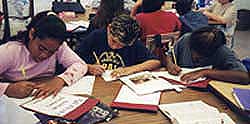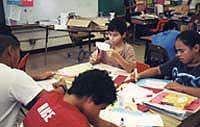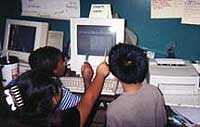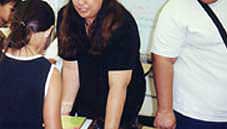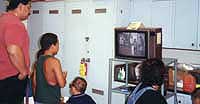![]()

Funded by a Student Teaching Grant from the College of Education
Written by Pohai Kukea
Background
I wrote this unit while I was student teaching in a fifth grade classroom and the focus of our social studies curriculum was United States History. I had found that making U.S. History meaningful for my students was a very difficult task. The events occurred hundreds of years ago in a place that most of my students have only seen on television. With the exception of the study of World War II, concepts and events such as slavery and the Civil War are devoid of meaning and connections to their lives.
However, I discovered that literature and drama were two very good ways to help make meaning out of these events. I conducted an integrated unit on slavery that connected to reading, writing, and of course, social studies. By using techniques such as read alouds, book clubs, writers' workshop and various dramatic reinterpretations, I hoped to bring meaning and ownership to the study of slavery and the Civil War.
Objectives
- Students will be able to describe and chronicle the life of a slave from slave ship to plantation life.
- Students will be able to compare and contrast the impact that Harriet Tubman, Sojourner Truth and Frederick Douglass had on United States history and the abolition of slavery.
- Students will be able to assess the role of the Underground Railroad and it's importance for fugitive slaves.
- Students will be able to understand the point of view of slaves based on their reading of fictional literature in Book Clubs.
- Students will be able to write research reports on various aspects of slavery using both primary and secondary sources.
Description of Project
Week One and Two
This unit is broken up into three distinct sections: the life of a slave from slave ship to the plantation, the study of three famous slaves and their contributions to the abolition of slavery, and the Underground Railroad. During the first phase of the project, the students were exposed to a variety of literature that described slave ships, auction blocks and plantations. The students were introduced to the unit using a read aloud called Many Thousand Gone, which is a book with tales and legends written by slaves. This is only one of many read alouds that the students were exposed to during this portion of the unit. The students responded to this literature in a variety of ways, such as dramatic interpretations, journal writing and creating graphic timelines.
After these read alouds, the students broke into various research centers to create a graphic timeline on the four major events in the life of a slave. They also created a rubric for this assignment so they could assess themselves and their peers. They were required to draw a picture and write about these four events for this project: kidnapped from Africa, slave ships, the auction block, and plantation life. Every night during this time, the students wrote a journal about how the research made them feel.

Student working on his graphic timeline
During this first phase of the project, the students started new book clubs by reading historical fiction books about slavery and completing reading responses. I gave book talks on four different books that took place during the time of slavery and the students chose which book they wanted to read. The book clubs were on going throughout the unit.
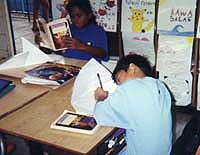
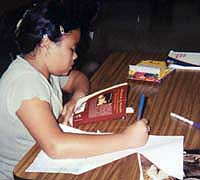
Students working on their Book Club reading responses
After the students completed their timelines, they were required to express what they learned in a different way - through drama. The students participated in many warm-up activities that enabled them to feel more comfortable with themselves and with each other. Then they did still photographs of different situations in small groups, such as mean older sibling and meek younger sibling. This made the transition into doing still photographs of the four major events in a slave's life very easy. The students broke up into their reseach groups and were given time to figure out how they could express those events in a still photograph. The students also received cameras from the grant, so when they gave their presentation, they took pictures of what they did and included them in their portfolios. I also video taped each group's performance so that the students could show the video when they shared their portfolios with their parents and peers.
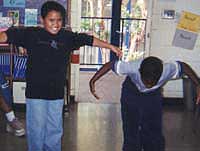
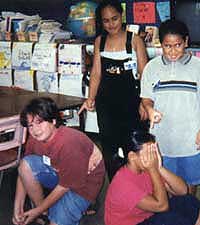
Students doing warm-up activities. The picture on the left shows the students following the directions, "One person make your body round, one person make your body pointy". The picture on the right shows the students following directions, "Make a still photograph of one person being the mean older sibling, and one person being the meek younger sibling."
This made the transition into doing still photographs of the four major events in a slave's life very easy. The students broke up into their reseach groups and were given time to figure out how they could express those events in a still photograph. The students also received cameras from the grant, so when they gave their presentation, they took pictures of what they did and included them in their portfolios. I also video taped each group's performance so that the students could show the video when they shared their portfolios with their parents and peers.

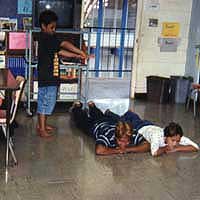
These first two still photographs are of the slaves getting kidnapped from Africa (on the left) and conditions on the slave ships (on the right).
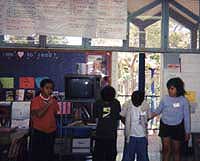
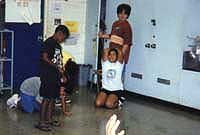
These next two still photographs are of the slaves on the auction block (on the left) and plantation life (on the right).
Week Three and Four
The next phase of the project started with read alouds about three famous slaves: Harriet Tubman, Sojourner Truth and Frederick Douglass. The students did character maps and Venn diagrams to respond and organize what they learned. First, we completed a character map about Harriet Tubman as a class. Then I had the students do a character map of Sojourner Truth and we came back together and did a Venn diagram as a class. The final read aloud was about Frederick Douglass and the students did a character map and a Venn diagram in their groups. After the initial introductions of these three individuals through read alouds, students chose one slave that they were particularly interested in and formed cooperative learning groups to research the slave that they chose. I then did a read aloud to introduce the Underground Railroad and to spark student interest in doing a project on the Underground Railroad.
|
The classroom then moved into a center-based format and the students rotated through various research centers. Since there were six cooperative learning groups, two groups researched each slave. Three of the centers were dedicated to the famous slaves, while the other centers focused on technology and the Underground Railroad. |
|
|
Students working on their famous slave research paper. |
|
|
One center was the computer center, where students were able to explore an interactive website on the Underground Railroad created by National Geographic. Another center was for the students to create an Underground Railroad manual. This was a chance for students to continue their research on the Underground Railroad and include a map of a possible route of a runaway slave. The students rotated through these six centers for about 2 weeks and all of the projects they did were included in their portfolios. The students also created rubrics for these assignments so they could assess themselves and their peers. |
|
|
|
Students working on their Underground Railroad manual and navigating through the interactive website. |
|
|
|
|
Week Five and Six (and beyond) The culminating event for the entire unit was a sharing of the students' portfolios. These two weeks were used to prepare their portfolios and finish up and polish any projects that they wanted to include in their portfolio. The students also created a rubric to help the assess themselves and their peers. During this time the students were also required to complete book reports on their book club books and present these reports to the class. The class also had many fishbowl discussions comparing and contrasting the different stories that they read from this time period. |
|
 |
Students working on polishing and putting together their portfolios. |
|
|
|
|
The final culminating event for this unit not only involved the students, but the parents and community as well. The students were required to organize all the work they produced into a single portfolio that they could share with their families. They had a menu in their portfolio, which included appetizers (various assignments from their work in centers and their best journal entries), main dishes (including their research report on a famous slave and their Underground Railroad manual), and desserts (book club reading responses and pictures from their drama activities). During this session, the students were required to explore and assess their peers' portfolios. Family members, other classes and other faculty members were invited to the classroom and the students had the opportunity to explain and share their portfolio with them as well. The classroom had different centers around the room: one center was dedicated to showing the video of the still photographs they did of the major events in the life of a slave, one center highlighted the different literature the students used, one center gave the visitors the opportunity to explore the interactive website the students used, and the final area was for the students to showcase their portfolios. The final culminating event for this unit not only involved the students, but the parents and community as well. The students were required to organize all the work they produced into a single portfolio that they could share with their families. They had a menu in their portfolio, which included appetizers (various assignments from their work in centers and their best journal entries), main dishes (including their research report on a famous slave and their Underground Railroad manual), and desserts (book club reading responses and pictures from their drama activities). During this session, the students were required to explore and assess their peers' portfolios. Family members, other classes and other faculty members were invited to the classroom and the students had the opportunity to explain and share their portfolio with them as well.
|
|
|
|
Student sharing their portfolio with members of their community. |
|
The classroom had different centers around the room: one center was dedicated to showing the video of the still photographs they did of the major events in the life of a slave, one center highlighted the different literature the students used, one center gave the visitors the opportunity to explore the interactive website the students used, and the final area was for the students to showcase their portfolios. |
|
|
On the right, students are showing the video of their drama activities with to their parents. On the left, students are sharing the rich literature they used for their research, book clubs and in read alouds. |
|
|
|
|
|
|
A student navigating through the Underground Railroad interactive website with her family. |
|
Assessment Plan Authentic assessment was an integral part of the unit. Students created grading rubrics for almost every major assignment, such as the research report on a famous slave. Self and peer assessment was also a big part of this unit. Students self assessed their work in groups on an almost daily basis. After creating rubrics for assignments such as their research reports, the students had an opportunity to examine each other's reports and give their peers a grade, based on the rubrics they created. Students also completed reading responses to the reading they did in their Book Clubs. These responses not only gave me the opportunity to measure their comprehension, but it also gave them the opportunity to be creative when responding to literature. |
|
|
|
An example of a self assessment done by a student. This rubric was created by the students and I made sure to honor their language use when typing it up. On the back of the page, the students were required to write a narrative on what they did well and what they could do better next time. |
The final form of assessment was not a test. Rather, it was the portfolios that the students created to share with their parents. The students included their best work from the various assignments they did throughout the unit. They had a menu for their portfolios (as described in the Description of Project section), that included work from every different type of activity they did. Before the families of the students come into the classroom, the students had the opportunity to examine each other's portfolios and grade them, again based on the rubric that they created. I used these forms of assessment to give the students ownership over their own learning, to create a community of learners, and to adjust my assessment strategies to the needs of my students.
I expected that 100% of my students would complete their final portfolio, and they did. While were more developed and detailed than others, I believe that this form of assessment allowed my students to work at their own pace and be creative in their presentations. I wanted to highlight each student's unique abilities and strengths, rather than give a generalized test that did not adjust to each student's needs. I did not believe that every student had to produce an identical portfolio; the students created a portfolio that was the best they could possibly do as an individual. I believe that this form of assessment was the only way to adjust to each student and each child was held up to their own highest standard.
Bibliography and Resources
Biographies
Adler, David A. A Picture Book of Harriet Tubman. New York: Holiday House, 1992.
- Good picture book to use as a read aloud and for research on Harriet Tubman's entire life.
Schroeder, Alan and Jerry Pinkney. Minty. New York: Dial Books for Young Readers, 1996.
- Good to use as a read aloud to introduce the study of Harriet Tubman.
Carter, Polly. Harriet Tubman. New Jersey: Silver Press, 1990.
- Covers the story of her childhood, escape from slavery and her role in the Underground Railroad. Good to use for research centers.
Macht, Norman L. Sojourner Truth Crusader for Civil Rights. USA: Chelsea House Publishers, 1992.
- Chapter book on the life of Sojourner Truth to be used in research center.
Adler, David A. A Picture Book of Sojourner Truth. New York: Holiday House, 1994.
- Good picture book to use as a read aloud and in research because it includes a map of her travels, which could be extended into a geography lesson.
McKissack, Patricia C. and Frederick McKissack. New York: Scholastic Inc., 1992.
- Chapter book to be used in research center. Also a good primary source.
Girard, Linda W. Young Frederick Douglass The Slave Who Learned to Read. Illinois: Albert Whitman & Co., 1994.
- Includes story of how Frederick Douglass learned to read, how he escaped from slavery and excerpts of his speeches. Good to use in research centers.
Banta, Melissa. Frederick Douglass Voice of Liberty. USA: Chelsea Publishers, 1993.
- Chapter book to be used in research centers. Includes pictures, newspaper articles and speeches.
Kerby, Mona. Frederick Douglass. New York: Franklin Watts, 1994.
- Chapter book to be used in research centers.
Miller, William. Frederick Douglass The Last Day of Slavery. New York: Lee & Low Books, Inc., 1995.
- Good picture book to be read as an introduction to the study of Frederick Douglass.
Meltzer, Milton ed. Frederick Douglass In His Own Words. Singapore: Harcourt Brace & Co., 1995.
- Good primary resource to use in research centers.
Non-Fiction
Medearis, Angela S. Come This Far to Freedom. New York: MacMillan Publishing Co., 1993.
- Describes the slave trade and conditions of slave ships and includes biographies of famous slaves. Good for use in research centers.
Meltzer, Milton ed. In Their Own Words A History of the American Negro 1619-1865. New York: Thomas, Y. Crowell Co., 1964.
- Good primary resource to use in research centers that talks about slave life from slave ships to the plantation.
Bial, Raymond. The Underground Railroad. New York: Houghton Mifflin Co., 1995.
- Good picture book about the Underground Railroad to be used in research centers.
Bial, Raymond. The Strength of These Arms: Life in the Slave Quarters. New York: Houghton Mifflin Co., 1997.
- Good picture book about every day slave life to be used in research centers.
Book Club Books
Melitte
Paulsen, Gary. Sarny
Read Alouds/Mini Museum/Research Books
Bradby, Marie. More Than Anything Else. New York: Scholastic, Inc., 1995.
- Fiction book about every day life and learning how to read. Good read aloud.
Hamilton, Virginia. The People Could Fly. New York: Knopf, 1985.
- Slave tales of freedom for read aloud.
Hamilton, Virginia. Her Stories. New York: Blue Sky Press, 1995.
- Good for read aloud or research. Includes not only folk tales, but also true stories told by the slaves themselves.
Hamilton, Virginia. Many Thousand Gone. New York: Knopf, 1993.
- Good primary resource with slave stories. Could be used in research or for a read aloud.
Ringgold, Faith. Aunt Harriet's Underground Railroad in the Sky. New York: Crown Publishers, Inc., 1997.
- Good read aloud about Harriet Tubman and the Underground Railroad. Could also be used in research centers because there is research material and a map at the back of the book.
Winter, Jeanette. Follow the Drinking Gourd. New York: Knopf, 1988.
- Good read aloud about the Underground Railroad. Could also be linked to music.
Wright, Courtni C. Journey To Freedom. New York: Holiday House, 1994.
- Good picture book and story about the Underground Railroad.
Lester, Julius. From Slave Ship to Freedom Road. New York: Dial Books, 1998.
- Book could be used as a read aloud or in mini-museum because of the fantastic pictures. Covers from slave ship to plantation life to escape and written as a narrative.
Johnson, Dolores. Now Let Me Fly. New York: Aladdin Paperbacks, 1993.
- Picture book about everyday slave life.
Johnson, Charles. The Middle Passage. New York: Atheneum, 1990.
- Tells the tale of the brutal trans-Atlantic Crossing through a series of 6 4 narrative paintings. Good to use as a mini-museum.
Hopkinson, Deborah. Sweet Clara and the Freedom Quilt. New York: Knopf, 1993.
- Clara listens to the stories of recaptured slaves to make a quilt to help herself and other slaves escape. Good to use as a read aloud.
Blockson, Charles L. "Escape from Slavery. The Underground Railroad." National Geographic. July 1984, Vol. 166, No.1, p. 3-39.
- Good photographs and information about the Underground Railroad that could be used in research centers or mini-museums.
Web sites
Kathy Schrock's Guide for Educators
http://www.school.discovery.com/schrockguide/history.html
- Links to different sites on all topics with lesson plans and ideas.
Africans in America
http://www.pbs.org/wgbh/aia/images/htoplayer3.map
- Lesson ideas and resources about all aspects of African American history.
The Underground Railroad @ NationalGeographic.com
www.nationalgeographic.com/features/99/railroad
- Great interactive site that allows participants to travel through the Underground Railroad and make choices about their escape.
Black Images of Freedom
http://lcweb.loc.gov/rr/print/082_slave.html
- Includes information about slavery and freedom with fantastic pictures allowing you to see the conditions under which slaves had to live.
Political map of the U.S. - Free and Slave States
http://lcweb.loc.gov/exhibits/african/reynomap.jpg
- A good primary source showing the dividing line between free and slave states.
Map of the Underground Railroad
http://education.ucdavis.edu/NEW/STC/lesson/socstud/railroad/Map.htm
- Good map of the Underground railroad.
The Ins and Outs of the Underground Railroad
http://www.geocities.com:80/Athens/Forum/9061/afro/underground.html
- Explains how the Underground Railroad operated and the people who were involved. Lots of good information.
Copyright 2000-2001 All Rights Reserved
